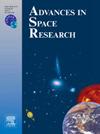利用 POD 为 GRACE 和 GRACE-FO 的热层密度检索进行有针对性的加速度计校准
IF 2.8
3区 地球科学
Q2 ASTRONOMY & ASTROPHYSICS
引用次数: 0
摘要
高层大气的密度可以通过低地球轨道卫星的轨道和加速度计数据确定,作为轨道沿线的现场测量数据。其中的一个主要挑战是估算物理加速度计校准参数,即这些参数不应吸收精确轨道确定(POD)过程中的其他影响和模型缺陷。所有大地测量卫星(如 GRACE 和 GRACE-FO)的加速度计都会受到时间偏差和比例因子的影响。我们为完整的 GRACE 和 GRACE-FO 任务开发了基于 POD 的动态物理加速度计校准。我们研究了不同的参数化策略,并利用了不同的观测数据,如精确的卫星间测距和 GPS 轨道数据。对于估算参数,我们区分了偏移和尺度,此外,交叉轨道和径向方向的敏感度明显低于沿轨道方向,需要进行不同的评估。对于偏移量,我们研究了恒定参数和随时间变化的参数。此外,还对弧线边界上的连续偏移校准进行了实施和测试。比例因子的灵敏度较低,但与偏移量相反,它随着总加速度的增加而增加。这意味着需要在更长的时间段内对其进行估算。我们研究了三小时到一个月的时间段以及重力场恢复(GFR)的结果。月比例因子给出了有价值的结果,至少在 x 轴和太阳活动不是很低的情况下是如此。尽管如此,我们也从月度结果中估算出加权常数比例因子,并将其用于后续的 POD,从而为大多数周期以及横轨和径向方向提供更真实的偏移结果。我们使用了几种不同的模型。我们的结果表明,用通常的指标(如拟合后的 POD 残差)进行验证并不能反映不同估计校准参数的质量。为了进行定量验证,我们引入了一种基于非重力加速度模型的方法。因此,首先要对模型的不确定性进行评估。我们将我们的标度参数与现有参考资料进行比较,并将完整标定与代尔夫特理工大学的最新结果进行比较。最后,我们展示了不同校准选项对检索密度的影响。整个 GRACE 和 GRACE-FO 任务的估计校准参数和非重力加速度可在我们的数据服务器 www.zarm.uni-bremen.de/zarm_daten 上获取。本文章由计算机程序翻译,如有差异,请以英文原文为准。
Tailored accelerometer calibration by POD for thermospheric density retrieval with GRACE and GRACE-FO
The density of the upper atmosphere can be determined by orbit and accelerometer data from low Earth orbit satellites as insitu measurements along the orbit. One main challenge therein is the estimation of physical accelerometer calibration parameters, meaning that these parameters should not absorb other effects and model deficiencies in the Precise Orbit Determination (POD) process. The accelerometers of all geodetic satellites like GRACE and GRACE-FO are affected by time dependent bias and scale factors. Therefore a calibration of the data is indispensable.
A dynamic POD based physical accelerometer calibration is developed for the complete GRACE and GRACE-FO missions. We investigate different parametrization strategies and utilize different observation data, as the accurate inter-satellite ranging additionally to GPS orbit data. For the estimation parameters we distinguish between offset and scale, furthermore, cross-track and radial directions are significantly less sensitive than along-track and require a different evaluation. For the offset, constant and time dependent parameters are investigated. Furthermore, a continuous offset calibration over arc boundaries is implemented and tested. The sensitivity of the scale factor is lower, although, in contrast to the offset, it increases with higher total accelerations. This means that it needs to be estimated over longer time periods. We investigate periods between three hours and one month as well as results from Gravity Field Recovery (GFR). Monthly scale factors give valuable results, at least for x-axis and when the Solar activity is not very low. Nevertheless, we also estimate weighted constant scale factors from the monthly results and use these in a subsequent POD, giving more realistic offset results for most periods and cross-track and radial directions.
From the used background models in the POD, Earth’s gravitational model has a noticeable influence on the estimated calibration parameters, especially the scale factors. We utilized several different models. Results with monthly ITSG solutions are distinctly better than the ones with the time dependent GOCO06s model.
We show that the validation with usual metrics, like post-fit POD residuals, is not able to reflect the quality of the different estimated calibration parameters. For a quantitative validation we introduce an approach based on the modeled non-gravitational accelerations. Therefore, the uncertainty of the models is evaluated first. The influence of main error sources in the models is assessed and propagated to the results.
We compare our scale parameters to available references and the complete calibration to TU Delft’s latest results. Finally we show the effect of different calibration options on the retrieved density.
The estimated calibration parameters and non-gravitational accelerations for the whole GRACE and GRACE-FO missions are available on our data server www.zarm.uni-bremen.de/zarm_daten.
求助全文
通过发布文献求助,成功后即可免费获取论文全文。
去求助
来源期刊

Advances in Space Research
地学天文-地球科学综合
CiteScore
5.20
自引率
11.50%
发文量
800
审稿时长
5.8 months
期刊介绍:
The COSPAR publication Advances in Space Research (ASR) is an open journal covering all areas of space research including: space studies of the Earth''s surface, meteorology, climate, the Earth-Moon system, planets and small bodies of the solar system, upper atmospheres, ionospheres and magnetospheres of the Earth and planets including reference atmospheres, space plasmas in the solar system, astrophysics from space, materials sciences in space, fundamental physics in space, space debris, space weather, Earth observations of space phenomena, etc.
NB: Please note that manuscripts related to life sciences as related to space are no more accepted for submission to Advances in Space Research. Such manuscripts should now be submitted to the new COSPAR Journal Life Sciences in Space Research (LSSR).
All submissions are reviewed by two scientists in the field. COSPAR is an interdisciplinary scientific organization concerned with the progress of space research on an international scale. Operating under the rules of ICSU, COSPAR ignores political considerations and considers all questions solely from the scientific viewpoint.
 求助内容:
求助内容: 应助结果提醒方式:
应助结果提醒方式:


